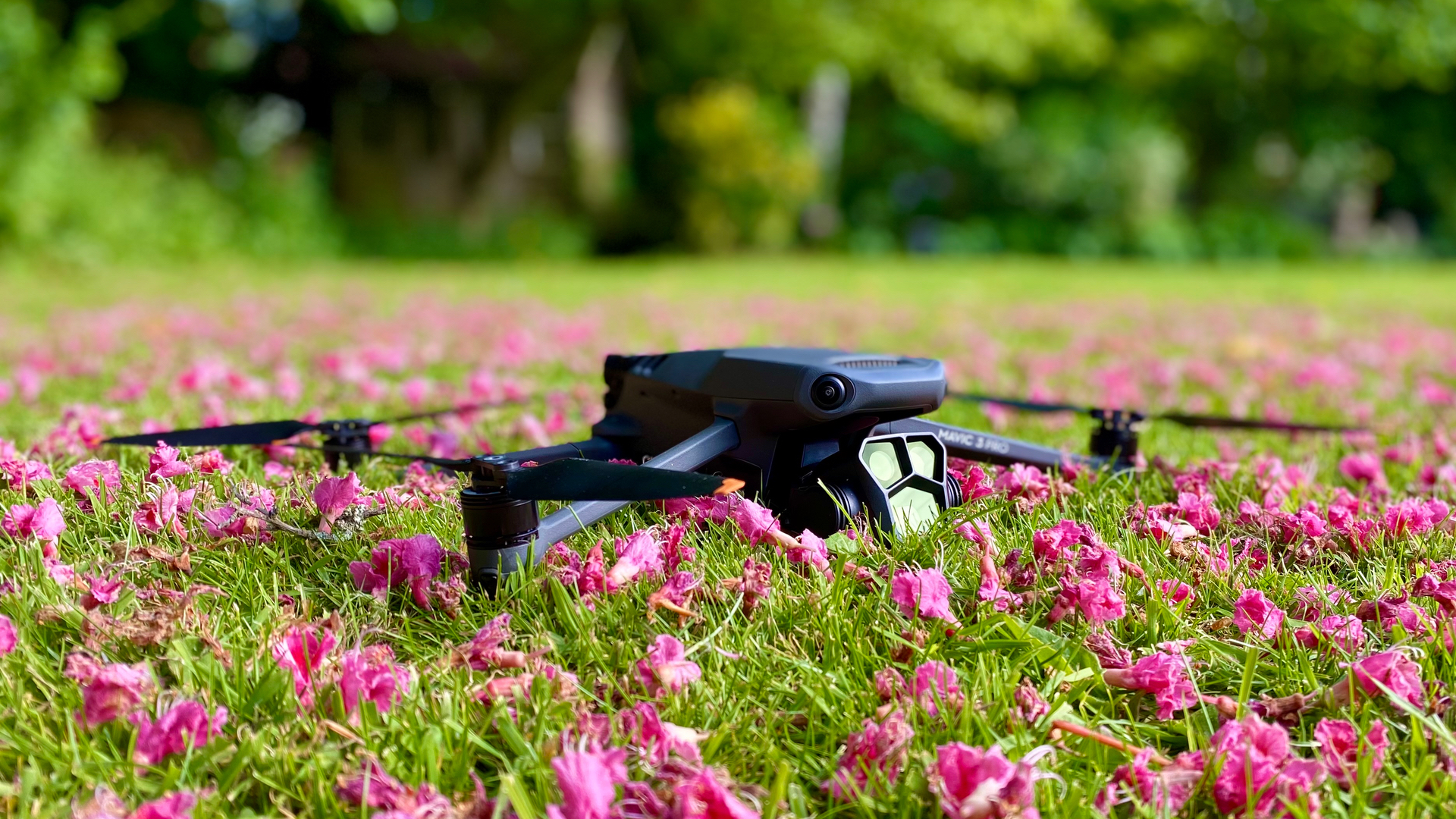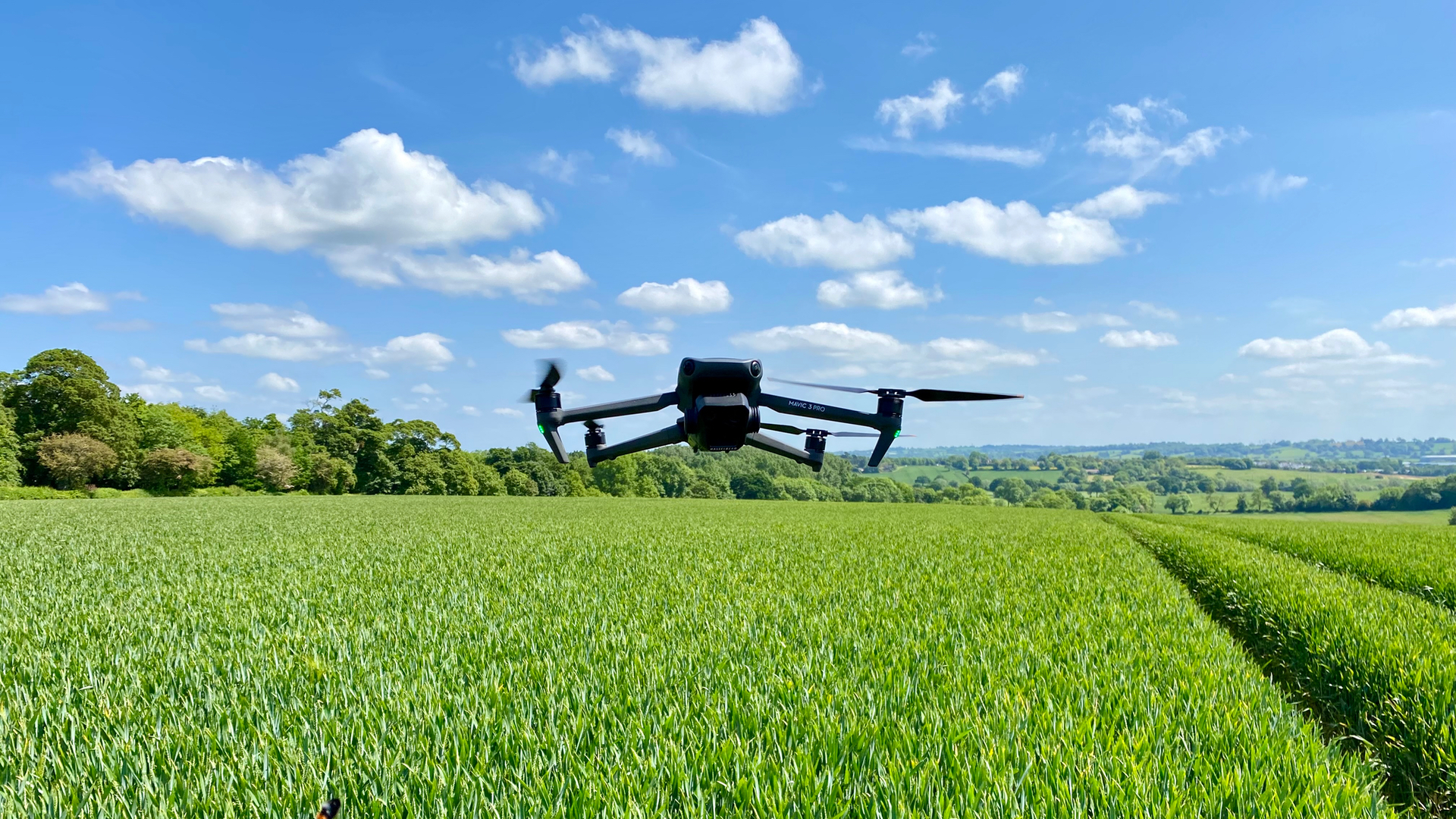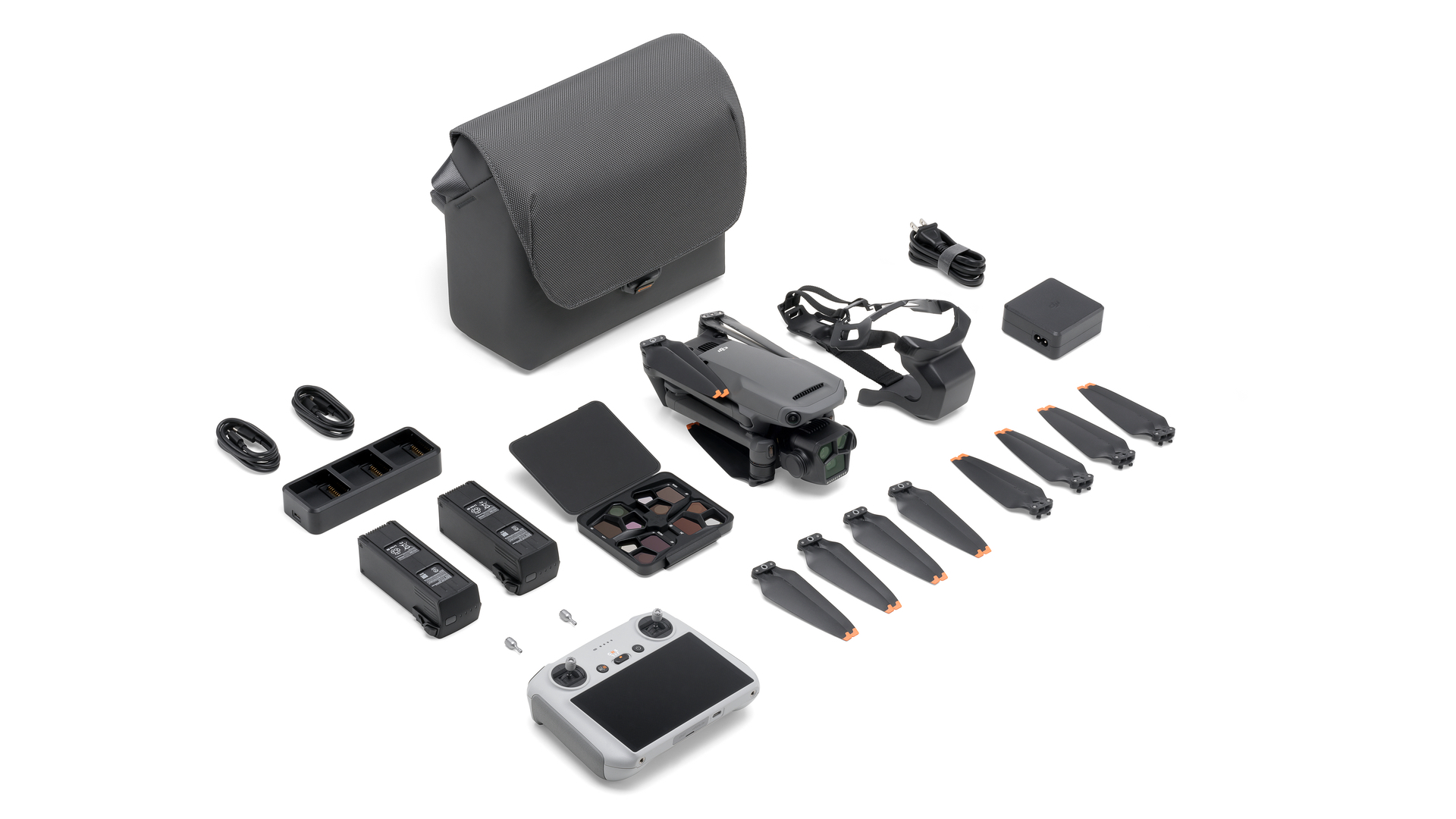DJI Mavic 3 Pro review: the ultimate prosumer drone
Shoot aerials like a true professional with DJI’s extraordinary new Mavic 3 Pro


With its three onboard cameras, the new DJI Mavic 3 Pro is every videographer and photographer’s dream. This drone not only flies impeccably well in most conditions but takes stunning 5.1K footage and razor-sharp images with glorious depth of field, just like a land-based camera. This drone really is the ultimate in aerial tripods.
-
+
Three cameras offer almost unlimited creative freedom
-
+
Shoots 5.1K video
-
+
Full obstacle sensing
-
+
43-minute flight time
-
-
A bit OTT if you're not serious about aerial videography
Why you can trust T3

Thanks to the three-camera setup, the DJI Mavic 3 Pro is probably one of the most exciting drones I came across in recent years, and I tested a lot of them. It's a unique offering from the most well-known drone manufacturer and one that we'll surely talk about for the next couple of years at least.
Let’s cut straight to the chase. The newly launched DJI Mavic 3 Pro is, without a shadow of a doubt, the finest camera-equipped prosumer drone we’ve ever reviewed. And, as our guide to the Best Camera Drones testifies, we’ve reviewed a fair share of drones over the past 10 years.
When the DJI Mavic 3 was launched in 2021, it bucked the trend by having two cameras – a wide-angle Hasselblad with a four-thirds sensor and a slim 7x zoom camera above it. Like most modern phones, this provided the option to shoot video and photos over a much wider focal range.
However, there was still a large gap between the wide-angle lens’s format equivalent of 24mm and the 162mm of the zoom camera. So DJI redesigned the camera housing for the Mavic 3 Pro and added a third medium tele camera with a 70mm lens that sits sweetly in the middle, which gives the new drone the ability to shoot video and stills like a mid-priced land camera, replete with cinematic depth of field compression and incredible parallax effects. It truly is a stunning achievement on DJI’s part, especially since the drone that carries the camera package has exactly the same spec as the current Mavic 3.
DJI Mavic 3 Pro review: price and availability
The DJI Mavic 3 Pro is available in several packages. The standard pack retails at £1,879 and comprises the drone, a grey RC controller with an integral screen, a single battery and two spare control sticks. The first of the Fly More Combos retails at £2,549 and includes the drone, RC controller, three batteries, a multi-charger, a set of ND filters and a shoulder bag. Finally, the second Fly More Combo option offers the same set of accessories but with the black RC Pro controller instead of the cheaper grey one. It costs a whopping £3,169.
You can buy most of these configurations from the DJI store, Amazon, Jessops and WEX.

How good is the new Mavic 3 Pro and should you buy it?
As a regular reviewer of consumer drones, I’m constantly amazed at how fast this area of technology has evolved. In fact, just ten years have elapsed since I reviewed the DJI Phantom 2 Vision, which blew me away with its 1080p video footage of the world from above. In hindsight, the footage it shot was crap, and it didn’t even have image stabilisation, but I, and everyone else who flew it, knew that camera-equipped drones would one day spell the end of hiring an expensive helicopter to shoot aerial footage.
Sure enough, these days, not even a big-budget Hollywood production studio needs to hire a helicopter anymore. They can just call on the services of a high-end drone like the new DJI Inspire 3, which, while extraordinarily expensive to buy, is still probably a lot less than the cost of hiring a chopper and an experienced pilot for just one day. What’s more, a drone can go places no chopper could ever risk going, and if it crashes, no one dies. What’s not to like?
At this juncture, I will stick my head on the block and say that while the Inspire 3 and other cinematic drones are capable of shooting staggeringly sharp cinematic footage with exceptional depth of field compression, I’m not sure I would be able to spot any glaring differences on my 49” Samsung TV between, say, what comes out of the Inspire 3 and what comes out of the new Mavic 3 Pro. That’s how good this little drone is.
Yes, you will need to get the right flying licence for it – which you can read about in our guide to UK drone regulations – but if you already fly camera drones for a living by shooting real estate, YouTube documentaries or even aerial movie-quality footage, I guarantee it will have paid for itself within one or two commissions.

DJI Mavic 3 Pro review: Design & Features
If you’ve ever flown a DJI drone, you’ll know how confidence-inspiring the experience is. Yes, like any drone, you may feel a natural nervousness before launching it, but once it lifts off the ground, all apprehensiveness disappears because everything about this drone – and I mean everything – is so accomplished, so reliable, and so simple, whether it’s flying in tight spaces, in a strong wind or way beyond the line of sight (illegal as it happens).
As mentioned above, the chassis, motors, four-way obstacle sensing and all flight controls on the Mavic 3 Pro are exactly the same as those on the current Mavic 3, which came out in November 2021. If it ain’t broke…
Granted, at 958g, the Mavic 3 Pro is 63 grams heavier than the Mavic 3 though you won’t notice this when carrying it in its optional shoulder bag. However, that extra camera weight does reduce flying time from 46 minutes to 43 minutes though the top speed in Sport mode – 47mph – is the same. Like the standard Mavic Pro 3, this drone has a maximum transmission range of a massive 15km.

DJI Mavic 3 Pro Fly More Combo with RC Controller Pro
DJI Mavic 3 Pro review: RC Controller
Aside from the different camera setup, the main difference between the Mavic 3 Pro and the earlier Mavic 3 is that the new model ships with DJI’s magnificent RC controller. This is a standalone remote with a built-in 5.5-inch HD display and 700 nits of glorious brightness. It beats using a mobile phone in so many ways, not least because you positively will not receive any annoying notifications from What’s App, texts, news apps and mail while you’re trying to concentrate on the drone. Also, it’s much quicker and far less hassle to use. Simply turn it on, and it quickly links to the Mavic 3 Pro with no faffing about with phone cradles and connecting wires.
Unlike the standard phone-screen controller, this one also has an extra zoom wheel on the right, which only works in video mode. However, it allows you to create smooth zooming, including the classic Hitchcock and Jaws ‘dolly zoom’ effect.
If you purchase the most expensive Fly More Combo, you get the black RC Pro controller with it, which has 1,000 nits of brightness and HDMI output for big screen monitoring. However, if you want to save money I would stick with the standard non-Combo pack and just buy an extra battery and DJI’s ND filter pack instead. Then buy a cheap shoulder bag from somewhere like Jessops and another battery when you can afford it.
Incidentally, if you already own a DJI Mavic 3, Mavic 3 Cine, Mini 3 Pro, Air 2S or Mavic 3 Classic, I advise you to buy the standard grey RC Controller because it will instantaneously revolutionise your flying experience.
DJI Mavic 3 Pro review: Main Camera
Okay, let’s get down to the meat and two veg. The main Hasselblad camera on the Mavic 3 Pro is the same as that on the Mavic 3. This is the camera to use for wide establishing shots and stunning landscape photography. At a format equivalent of 24mm and with an aperture range of f/2.8-f/11 and an 84˚ field of view, this camera produces imagery that truly knocks the socks off – rich, highly detailed, and with a true cinematic punch. And with its ISO range of up to 12,800, it takes amazing noise-free low-light images, too. For still photographers, the main camera produces 20mp images in both JPEG and RAW and two aspect ratios – 16:9 and 4:3. Sadly, there is no option to select 3:2 for a slightly wider shot.

A wheat field taken with the main 24mm Hasselblad camera
In terms of video, the Hasselblad can shoot in 5.1K at up to 50 frames per second and 4K at up to 120fps. For the smoothest results, choose 25fps which is the norm in cinema, but if you think you’ll want to slow down the footage in post, then choose a higher frame rate. This camera also supports four colour modes – normal, HLG, D-Log and D-Log M.
DJI Mavic 3 Pro review: 3x Zoom Camera

The same wheat field taken with the new 3x mid-tele lens
The all-new 70mm medium tele camera is a revelation for aerial photography since it allows you to zoom in without affecting image quality and without having to fly the drone nearer to the subject. The camera has a 35˚ field of view and a fixed aperture of f2.8 – great for shooting with a shallow depth of field. You can zoom in up to three times with this camera without affecting image quality too much. If you’re a photographer, you will find this versatile lens a godsend.
DJI Mavic 3 Pro review: 7x Zoom Camera

The same wheat field taken with the 7x zoom lens
The 7x zoom camera is similar to the standard Mavic 3’s only with a slightly longer focal range (166mm against the earlier 162mm), 10 more frames per second in 4K and with a larger aperture (now f3.4 instead of f4.4). This extra stop on the aperture makes for much better low-light shooting and stunning compression when taking images or video of a subject in the foreground.
You can really create some lovely bokeh (background blur) with this lens if focusing on a subject at a high enough altitude (like on top of a mountain) and with a sweeping vista in the background – just like a land-based camera lens with a large aperture or a long zoom. And if the drone is moving side to side, the lens creates striking parallax effects with the sharp foreground seemingly in a static spot while the whole background shifts to the side, 3D style. It's also a great lens for filming wildlife without disturbing animals and, with the extended digital zoom function, brilliant for scoping out distant subjects.

The basic DJI Mavic 3 Pro Fly More Combo with grey RC Controller
DJI Mavic 3 Pro review: DJI Fly app features
DJI’s Fly app has always been amazing to use. Pretty much anything is possible within the app, whether it’s adjusting flight parameters or a myriad of camera settings. The app also provides the wherewithal to select from a range of Quick Shots – orbit, zoom, drone etc. – plus Mastershot, which instructs the drone to carry out a sequence of manoeuvres around a chosen subject. You can then edit the Mastershot in the app or by using editing software like Final Cut and Adobe Premier. As before, there’s also a Hyperlapse setting which produces an amazing moving timelapse.
Furthermore, a recent firmware update in the app now lets the pilot select waypoints. This is a brilliant addition since it allows you to either fly and record the route or set up a route from home using the built-in map. Once saved, you can return to the same spot on a different day, and the drone will follow the same route and video the same subjects as before.
For safety, the app also features AirSense, which lets the pilot know if there’s a piloted aircraft in the vicinity. I can tell you that it works remarkably well, even with light aircraft, since I’ve had two such warnings, and both came to fruition, albeit about two minutes later. You will also get an ‘altitude’ warning if in the vicinity of an airfield. Simply set your maximum flight altitude accordingly.

DJI Mavic 3 Pro review: Verdict
If you are genuinely serious about aerial videography and/or photography, you simply won’t find a more versatile and downright amazing drone for the money. The Mavic 3 Pro’s triple camera system opens doors to a huge variety of cinematic opportunities, and the accompanying RC controller is a revelation. Honestly, if used professionally, this drone will pay for itself very quickly, possibly after just one or two commercial operations. And that definitely makes it a price worth paying.
Sign up to the T3 newsletter for smarter living straight to your inbox
Get all the latest news, reviews, deals and buying guides on gorgeous tech, home and active products from the T3 experts
Derek (aka Delbert, Delvis, Delphinium, Delboy etc) specialises in home and outdoor wares, from coffee machines, white appliances and vacs to drones, garden gear and BBQs. He has been writing for more years than anyone can remember, starting at the legendary Time Out magazine – the original, London version – on a typewriter! He now writes for T3 between playing drums with his bandmates in Red Box (redboxmusic).
-
 Polar’s new subscription feature lands in the shadow of Garmin’s Connect+ rollout
Polar’s new subscription feature lands in the shadow of Garmin’s Connect+ rolloutPR genius or timing disaster? Polar’s new Fitness Programme adds adaptive training to its ecosystem
By Matt Kollat Published
-
 New Orient Star watches offer a glimpse of the magic within
New Orient Star watches offer a glimpse of the magic withinThere are two new skeleton pieces
By Sam Cross Published
-
 Netflix's most surprising 100%-rated sci-fi series returns with gorgeous trailer
Netflix's most surprising 100%-rated sci-fi series returns with gorgeous trailerLove Death + Robots is back for more
By Max Freeman-Mills Published